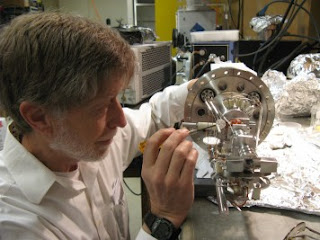 |
| Allen Mills in Lab. (ucr.edu) |
It is known by the scientists, that the matter has antimatter in nature. Based on first assumed, total of matter and antimatter at least same. But in fact, it is not enough antimatters have been finding so far. However, is antimatter differently under the influence of gravity compared with the material? Physicists at the University of California, Riverside have set out to determine the answer. Should they find it, it could explain why the universe seems to have no antimatter and why it is expanding at an ever increasing rate.
Experiments they do begins with measuring the free fall of positronium. Positronium is a system consisting of an electron and a positron (antimatter of an electron) that constitute an "atom". However, this state is unstable. So that the two particles annihilate each other and form two gamma ray photons.
In experiments conducted by David Cassidy and Allen Mills, a positron and an electron are separated by using a laser. As a result, this system will reject the effect of annihilation. In this way, they have many opportunities to measure the effects of gravity.
“Using lasers we excited positronium to what is called a Rydberg state, which renders the atom very weakly bound, with the electron and positron being far away from each other,” said Cassidy, an assistant project scientist in the Department of Physics and Astronomy, who works in Mills’s lab. “This stops them from destroying each other for a while, which means you can do experiments with them.”
In the case of positronium, Cassidy and Mills, a professor of physics and astronomy, were interested in achieving a long lifetime for the atom in their experiment. At the Rydberg level, positronium’s lifetime increases by a factor of 10 to 100.
“But that’s not enough for what we’re trying to do,” Cassidy said. “In the near future we will use a technique that imparts a high angular momentum to Rydberg atoms,” Cassidy said. “This makes it more difficult for the atoms to decay, and they might live for up to 10 milliseconds – an increase by a factor of 100,000 – and offer themselves up for closer study.”
“We will look at the deflection of the beam as a function of flight time to see if gravity is bending it,” Cassidy explained. “If we find that antimatter and matter don’t behave in the same way, it would be very shocking to the physics world. Currently there is an assumption that matter and antimatter are exactly the same – other than a few properties like charge. This assumption leads to the expectation that they should both have been created in equal amounts in the Big Bang. But we do not see much antimatter in the universe, so physicists are searching for differences between matter and antimatter to explain this.”
This article has edited by authors of threelas
Source: http://ucrtoday.ucr.edu/2184
Publication: http://prl.aps.org/abstract/PRL/v108/i4/e043401
Post a Comment